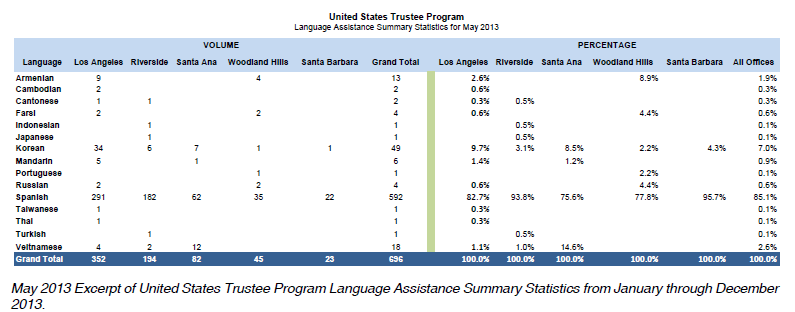Language Barriers
Pro Se filers facing a language barrier are doubly disadvantaged in failing to obtain counsel in addition to being unfamiliar with the bankruptcy process. The large number of Spanish requests and the variety of languages requested both serve to underscore the need for interpretation services even before a filer meets with a trustee for the meeting of creditors. This is especially true given that immigrant populations are often targeted by bankruptcy petition preparers (BPPs). The chart below summarizes the language assistance requests received by the United States Trustee in one month for the meeting of creditors.

In an effort to study the correlation of the predominance of Spanish speakers with the use of bankruptcy petition preparers, the following charts map Spanish speaker households (using census data) with known BPPs. The maps display the distribution of BPPs (indicated by yellow graduated circles) in relation to the Spanish-speaking population (indicated by the blue color gradient) throughout the District. A correlation is evident between bankruptcy petition preparer locations and the concentration of Spanish-speakers throughout the District, which is believed to be related to the prevalence of BPPs who advertise themselves as Notarios in Latino immigrant communities. Notarios are non-attorneys who provide various kinds of legal assistance to clients. According to a Harvard Latino Review article, What’s in a name?: Notarios in the United States and the exploitation of a vulnerable Latino immigrant population, by Anne E. Langford, approximately 20 percent of all Latino immigrants in the United States have hired a Notario for legal assistance (2004:115-136). Unfortunately, due to the problematic translation of the word Notario, many individuals may misunderstand the nature of the services they are receiving. Throughout much of Latin America – including Mexico, Argentina, Peru and Honduras – the word Notario signifies a professional with actual legal training; in the United States, however, the term is used primarily by non-attorneys who have no legal training beyond that of a Notary Public.
BPP locations are based on the disclosed business addresses from a sample of nearly 500 “BPP-flagged” petitions filed in September and October of 2013. Some bankruptcy petition preparers were more heavily represented in the sample than others (some filed as many as 35 petitions within the sample; while others filed only one) and this is represented in the map using graduated circles to illustrate the number of petitions filed by BPPs. The data is limited because there was no way to quantify the great number of undisclosed BPPs, but we believe the limited sample provides a fair and accurate estimate of the location BPP activity. A clustering of BPPs is apparent in the following cities with high Spanish-speaking populations: East Los Angeles, Downey, Fontana, and the City of Santa Ana. While the charts simply provide generalized correlations between BPP activity and Spanish speakers, they may provide our many pro bono attorney partners with some guidance on where Spanish language outreach may be most effective.
A Closer Look: By Division: Los Angeles | Riverside | San Fernando Valley | Santa Ana | Northern


